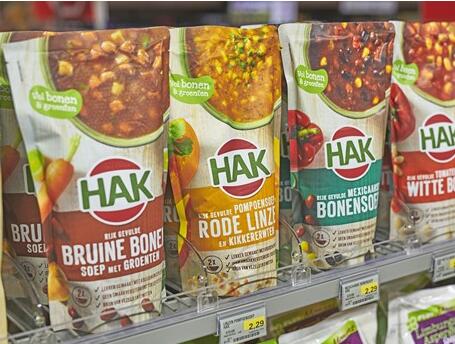“Within the category, we’ve seen legumes being the driving force,” says Nicole Freid, manager of marketing and innovation for HAK. “The legume market is growing most strongly.” In 2015, the company started a campaign in cooperation with Dutch chef Herman den Blijker to promote beans and legumes. This coincided with an increased focus of consumers on eating healthy, and the Dutch Dietary Centre also paid more attention to legumes. “You can tell all of this combined has resulted in an increasing trend, and this also pushes the development of our entire category.”

More variation in meat substitutes
For HAK, the legumes are a spearhead for continued growth. With it, the company responds to the trend of consuming more vegetable proteins and less meat. More than 50 per cent of the Dutch calls themselves flexitarian. “More and more people choose to skip meat on some days, and that group wants more variation on the days they don’t eat meat,” Nicole explains. “Because beans are naturally rich in vegetable proteins, they’re an ideal alternative for days without meat.”
Increased demand isn’t a problem for supply. “It can be challenging to find legumes that meet our high quality requirements.” Despite growth, Dutch consumption is still behind the average European bean consumption. The Dutch consume about a fifth of the amount consumed on average in Europe.
Beans a spearhead for growth
HAK expects the increase in legumes to last in coming years with good reason. In the past four years, the category’s turnover increased by 25 per cent. “That’s why we made it into a spearhead of our strategy,” Nicole continues. “We already were the market leader in legumes, but we want to continue building on the category.” To that end, beans are promoted on two fronts. On the one hand, legumes still have a somewhat old-fashioned image. “Many people think of brown beans and traditional dishes. So popularising the legumes, showing how many different varieties there are, how easy to use and delicious they are, that’s our job.”
To meet consumers, the assortment consists of various bean dishes. These are a bit like a starter model, such as the Bolognese dish, a pasta sauce with lentils instead of mincemeat. “We stay close to the consumer with this, and we don’t make the switch to legumes too exciting,” Nicole explains. For more experienced legume consumers, there’s an assortment of exotic beans available, the second front on which legumes are promoted. Chickpeas, kidney beans and lentils are examples of these more exotic beans.
Food trends often get started in large cities, and it’s the same for the development of the legume market. “We’re seeing a clear difference in the penetration of the exotic beans between urban areas and the rest of the Netherlands.” In cities, the consumption of beans is larger than outside of urban areas. Nicole mentions the difference in consumption pattern between these two areas. Outside of the cities, weekly menus are more traditional than in cities, which feature salads more often, and where more flexitarians and vegetarians live on average.
Cooled beans
Last year, HAK acquired the Peter van Halder company located in Brabant. Upon the takeover, it was announced HAK would start operating in the cooled segment. “Behind the scenes, we’re working on all kinds of developments,” Nicole says. “We want to apply the mission we already have to the cooled segment as well: helping people to eat more vegetables and legumes.” In product development within this category, legumes play a leading role as well. “We want to introduce legumes to as many consumption moments and applications as possible, and we want to continue building on the segment with what we’re good at.”
‘No week without beans’ is the slogan of HAK’s latest campaign to bring legumes into the limelight. “This way, we want to scale up our mission and help consumers to consume legumes weekly – in line with recommendations of the Dietary Centre – because we’ve seen this is difficult for people,” Nicole explains. The campaign, once again featuring Herman den Blijker, should also offer inspiration to consumers to increase consumption. “Besides, we want to make clear how healthy beans are, in addition to how varied and delicious they are,” Nicole concludes. “Taste is most important, but it’s the first hurdle as well.”







